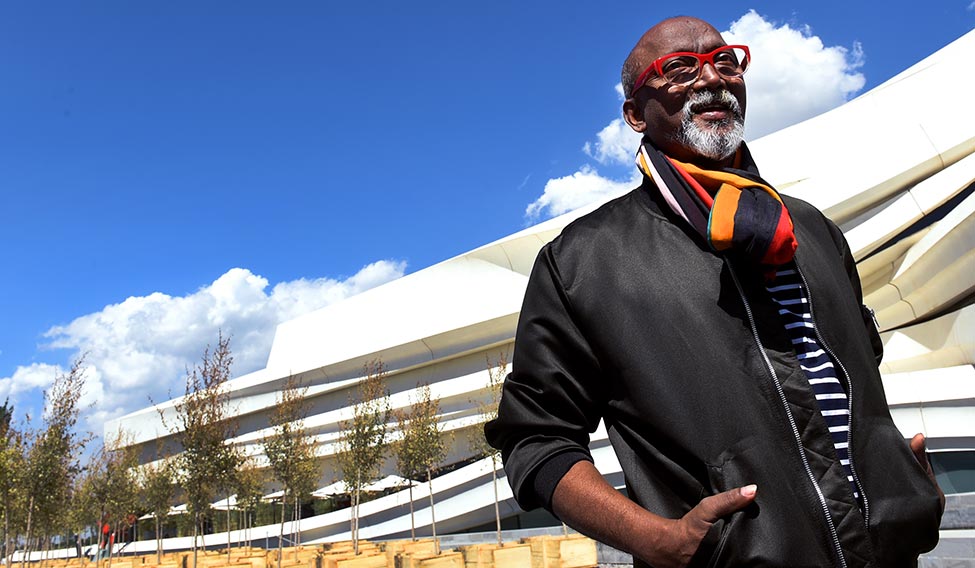Artist and curator Bose Krishnamachari doesn’t seem ruffled by the daunting task of curating the first biennale in Yinchuan, the capital of the Ningxia province of China. On the first day of the biennale which is titled For An Image, Faster Than Light and is taking place from September 9 to December 18, I see him loping about the Museum of Contemporary Art (MOCA), where it is taking place, in a leisurely fashion, often with his arm around a friend, occasionally pausing to oblige a shutterbug or a reporter, always with a smile on his face. I ask him whether he was nervous.
“No, I wasn’t nervous,” he says. “Although putting up such a large project in 18 days was a challenge.”
A curated show is like a nerve system, he says. You need to understand exactly where to place a work and how to decide what work goes next to it. “Understanding lighting and space is very important,” he says. “I was also interested in the detailing. When you conceptualise such a project, the architecture is dominating. You need to overcome that domination within the structure itself. I have treated it almost like the flow of a river; focusing on the fluid nature of the architecture and interiors.”
There are two qualities which distinguish Krishnamachari. He’s fully committed to the projects he takes on, whether it is in Kochi or Yinchuan. “I have had to give up many things but I don’t regret any of it,” he says. “I have a wonderful family but I don’t spend much time with them. This is a kind of sacrifice I’ve had to make.” He is also a highly futuristic thinker, right from the beginning when he put up a show called AmUseuM in Mumbai in 1992, piling up books in sculptural forms and burning them, at a time when people didn’t spend much on art productions. He focuses not just on the product but also on the process, ideating on interesting themes. In his show De-Curating, for example, he spent three years travelling across India, meeting and interacting with Indian artists and creating a canon of 94 sketches and paintings of them.
From a village in Kerala, where he says he lived like the proverbial frog in the pond, thinking he knew everything, he moved to Mumbai in 1985 to study at the J.J. School of Art and that’s where his journey started. He calls Mumbai the “university of his life”. “I used to go to Jehangir Art Gallery and watch all the exhibitions, good and bad, and occasionally help artists like Nalini Malani and Vivan Sundaram put up their shows,” he says.
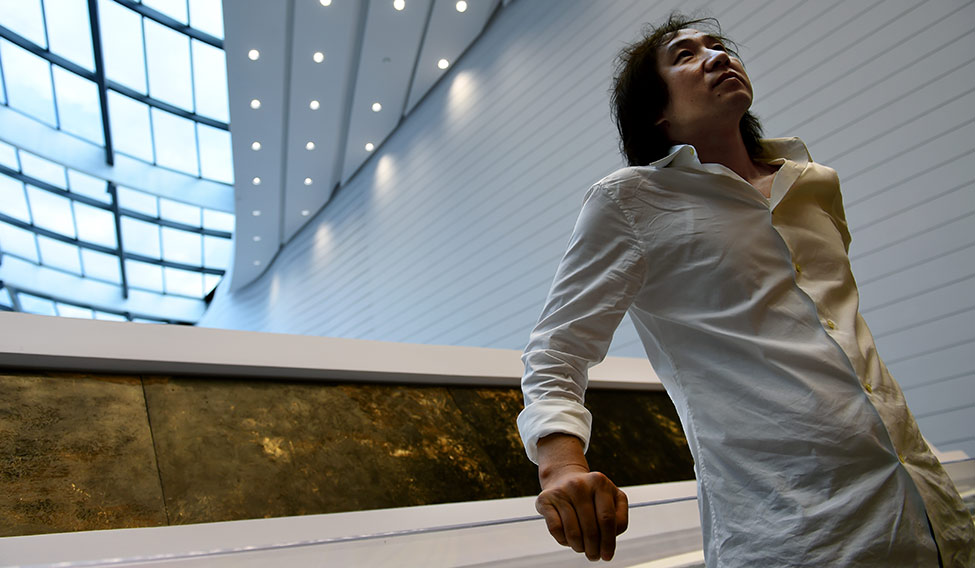 Art for art’s sake: Yang Hongwei is displaying a panel of wood engraving.
Art for art’s sake: Yang Hongwei is displaying a panel of wood engraving.
But perhaps his biggest achievement was curating the first Kochi-Muziris biennale in 2012 in which more than 75 artists took part. One might call it the stepping stone to Yinchuan, as it was at a talk he gave about the Kochi biennale in Tokyo that Suchen Hsieh, artistic director of the MOCA, approached him about curating a biennale in Yinchuan. Always ready for a challenge, he took on the project, bringing together more than 70 artists from 34 countries.
Yinchuan is a city in the northwest of China and the capital of the Ningxia Hui Autonomous Region. It was originally founded more than 1,300 years ago and is inhabited by many ethnic groups like Han, Hui, Manchu and Mongolian people. It also has a considerable Islamic population and used to be a stop in the silk route. Upon your first glimpse of Yinchuan, en route to the museum, it seems bleached of character, full of tree-lined avenues, wide roads and identical sky scrapers. It could have been a city anywhere in the world.
As Damian Christinger, a gallerist and freelance exhibition organiser from Zurich, said: “Here is a museum in the middle of nowhere. In 10 years, it could be the centre of a new city. Usually, museums come up to capture the atmosphere of a city. Here, it is the other way around. You’re starting a city with a museum.”
I would have been inclined to agree with him if we hadn’t got a chance to explore the city by night. We went downtown, to a square surrounding the drum tower, about an hour from the museum—an area full of pagodas, pavilions and mosques—a wonderful amalgam of traditional Chinese and Islamic architecture. The place was brimming with life: a shaggy street musician strumming soulful numbers, a man drawing portraits by a sausage stall, two flash dances with middle-aged men and women sashaying down the pathway and, a little way off, a traditional street play with the drumbeats reminding me of a Kathakali performance.
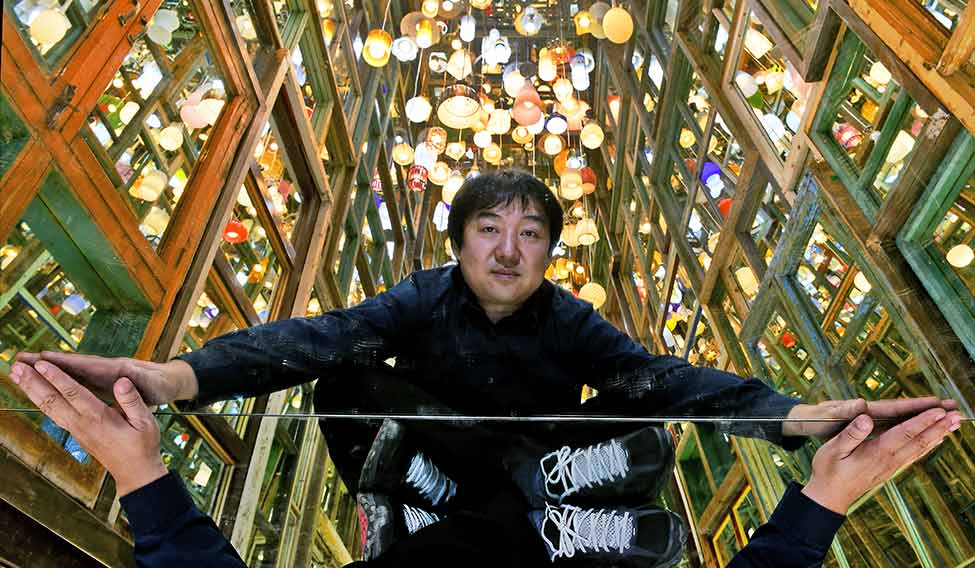 Window to the soul: Chinese artist Song Dong’s sculptural installation.
Window to the soul: Chinese artist Song Dong’s sculptural installation.
The MOCA, encompassing 15,000 square metres, is situated along the western banks of the Yellow River and surrounded by natural wetlands. The museum, with its clean lines, smooth planes and minimalistic interiors, looks a little like a spaceship from a Star Trek flick stationed in an organic paddy field. It is the first contemporary art museum along the Yellow River in northwest China. The biennale consisted of a diverse mix of artworks ranging from science-related projects to prints, new media works, photographs, installations, videos and sculptures. Most of the pieces were highly conceptual. Australian artist Tim Silver, for example, exhibited a striking nude of timbermate woodfiller with accompanying photographs. Lisa Reihana, a multi-disciplinary artist of Maori descent, showed a dark video installation of 14 minutes called Tai Whetuki—House of Death Redux, which delineated Maori and Pacific cultural practices pertaining to death and mourning. Some works were autobiographical, like that of Boedi Widjaja, an artist from Singapore. In his work, Lay down your weapon, follow me, he created an installation of 28 pecis (a type of cap worn in Indonesia and popularised by Sukarno as a symbol of nationalism) arrayed on a vintage camera tripod and custom brass support. He had to leave his family in Indonesia because of ethnic tension in 1984. The peci is used as the symbol of an identity he was supposed to have.
A residency programme for artists ran concurrently with the biennale at MOCA’s international artists’ village with many artists creating site-specific works. “My idea was to show that human imagination is faster than light,” says Krishnamachari. “For that, we used both the indoor and outdoor spaces. The juxtaposition of Yoko Ono’s installation of 100 coffins in front of the museum made a strong ecological statement on how people treat the land. I was interested in how artists use language. Cristiana de Marchi [who translated 30 articles of the United Nations Declaration of Human Rights into Braille to show how humankind is blind to human rights violations], for example, created images originating from a dark space. I wanted to show that, in a way, darkness carries light.”
Perhaps the most striking work was that of a Chinese artist called Mao Tong Qiang. With a mix of wood, mirror, furniture, audio, neon light, hallucinogen, fruits and the garbage of KTV, he created a room bathed in red light with dusty furniture mimicking the living space of a cocaine addict and juxtaposed it with images of Chairman Mao Zedong visiting the red guards for the first time in 1966. “The work represents a combination of the highest points in the artist’s political and personal situation,” his translator explains to me. When I point out the scarcity of political works by Chinese artists in the biennale, he tells me that everything is related to politics anyway. “My work represents the confusion of the living condition in China; the desire for freedom of speech, movement and conducting free and fair elections.”
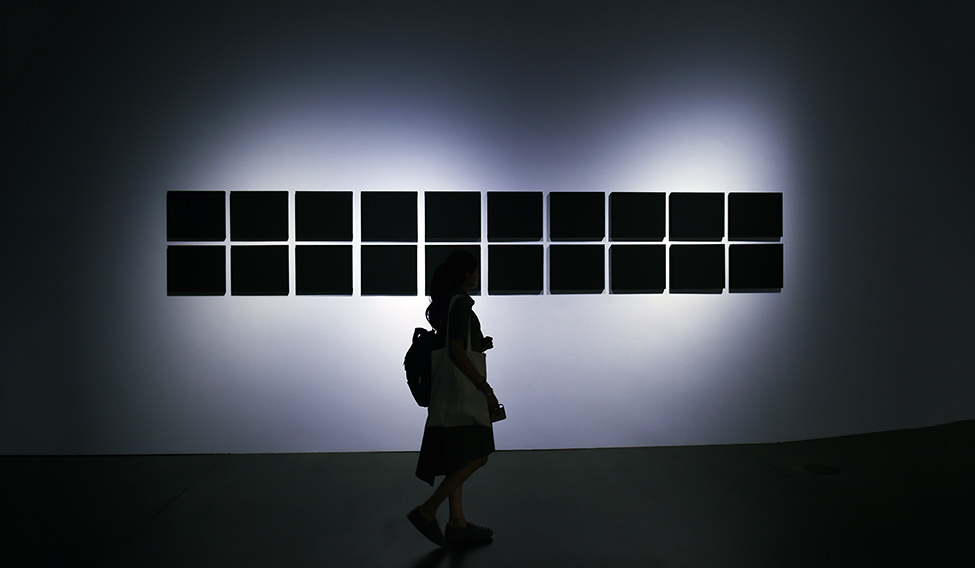 Love is blind? Cristiana de Marchi wanted to show that humankind is blind to human rights violations.
Love is blind? Cristiana de Marchi wanted to show that humankind is blind to human rights violations.
Out of the works of 12 artists from China who exhibited at the biennale, Qiang’s was one of the few with overtly political overtones. “When it comes to art, it is better not to use images of important political figures,” says Yang Hongwei, another Chinese artist who is displaying a panel of wood engraving of scenes from 21st century global history, from the Iraq War to the 9/11 terrorist attacks on the twin towers. “You have to be smart when it comes to politics, which you can represent in an indirect way,” he says. “It is meaningless to get into a fight with the government.” He makes an oblique reference to Chinese celebrity artist Ai Weiwei and says he admires people who can criticise the government but not if it is for fame and money. “Avant-garde art in China fell because it compromised to capitalism,” he says. As for him, he believes in transforming his relationship to society through his work and, through the process, “reality is turned into something spiritual”.
Artist Riyas Komu, who co-curated the Kochi biennale with Krishnamachari, feels that with the exception of a few Chinese artists who are making remarkable interventions into Chinese history and politics, the rest are mostly “image makers” whose work revolves around a certain kind of symbolism. “In India, because we’re democratic and free, that spirit is reflected in art,” he says. “Indian art is continually evolving. Obviously, we don’t have an Ai Weiwei but we still have a diverse context of languages.”
Despite this fundamental difference, the styles of some artists from China and India might be comparable, says London-based curator and writer Shaheen Merali. “Take the works of Sudarshan Shetty and Song Dong at the biennale,” he says. “Both are architectural structures made of recovered wood with immersive spaces you can walk through. The fact that they’re placed next to each other highlights such similarities.”
Dong exhibited a piece made from old windows discarded by different families which were used to represent a wall. “You can stand on either side of the wall,” he says. “Through my work, I wanted to show the importance of breaking down walls between cultures and countries. The blood of art is freedom. For me, my life has become my art and my art has become my life.” The wall seems to be a favourite motif with the Chinese artist. He came to India in 1999 and did a performance piece called Song Dong Came Here and Faced the Wall, in which he imitated the great Indian monk Dharma, quietly sitting on a bed and facing the wall for 10 days.
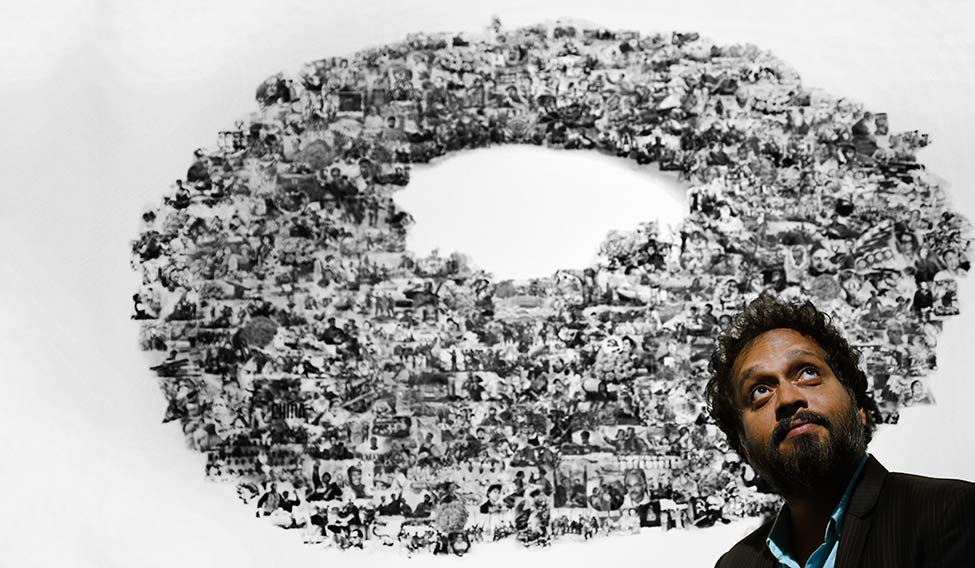 The ideologue: Riyas Komu with his work.
The ideologue: Riyas Komu with his work.
Other than Dong, a few Chinese artists have made interesting forays into Indian territory and vice versa. One of them, Li Huasheng, went to the Himalayas in the 1990s and lived in Buddhist monasteries, which changed his perspective on art. Instead of landscapes, he tried to depict the state of mind of the artist experiencing the landscape. This led to a fascinating series of ink art consisting of vast grids of horizontal and vertical lines, “like an embodied EKG of his being in time”. One of the notable works by an Indian artist in China is that of Tushar Joag. In 2010, the artist drove a motorbike for 55 days from Mumbai to Shanghai via the Sardar Sarovar Dam in Madhya Pradesh and the Three Gorges Dam in Hubei province in China, two controversial development projects. The resulting paintings and photographs threw light on the harm being done to the people of both countries as a result of the projects.
Other than such individual expeditions, there have been very little cultural exchange between the two nations in recent times. “I remember curating a show called 11th Hour in Beijing in 2010, featuring the work of 12 artists from India including Shilpa Gupta, Sudarshan Shetty and Tejal Shah,” says Merali. “I called it the 11th Hour because I wanted to revive the cultural exchange that took place between the two countries earlier. And then it seemed to stop. Here we are in a networked society where few Chinese artists have shown in India despite a lot of international work coming from the country.”
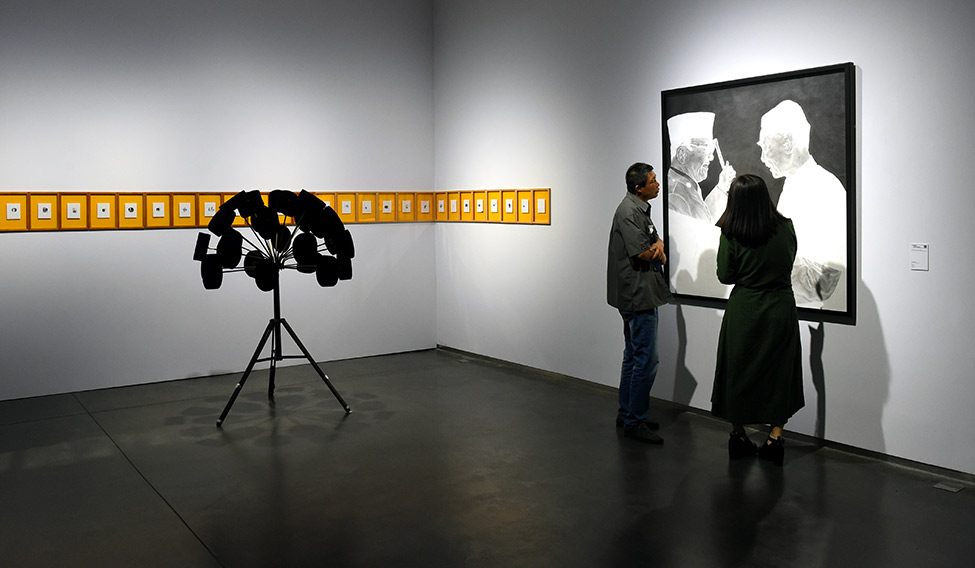 Art is life: Boedi Widjaja created an installation of 28 Indonesian caps arrayed on a camera tripod.
Art is life: Boedi Widjaja created an installation of 28 Indonesian caps arrayed on a camera tripod.
When I attended the sixth edition of the India Art Fair in Delhi in 2014, it was the first time a delegation of Chinese artists and collectors were coming to the fair. “I think the day when the art world was centred around New York and London is long gone,” Philip Dodd, chairman of the company Made in China (UK) Ltd, told me then. “The world is moving east. The only people who don’t know that are people in the east.” He told me that we were at the grand zero of what might be the relationship between India and China. According to Jonathan Stone, chairman and international head of Asian Art, Christie’s, there was a pan-Asian movement between India, Japan and China before World War II and the rise of fascism in Japan. “I think that has been forgotten today,” he told me. “We need to revive that.”
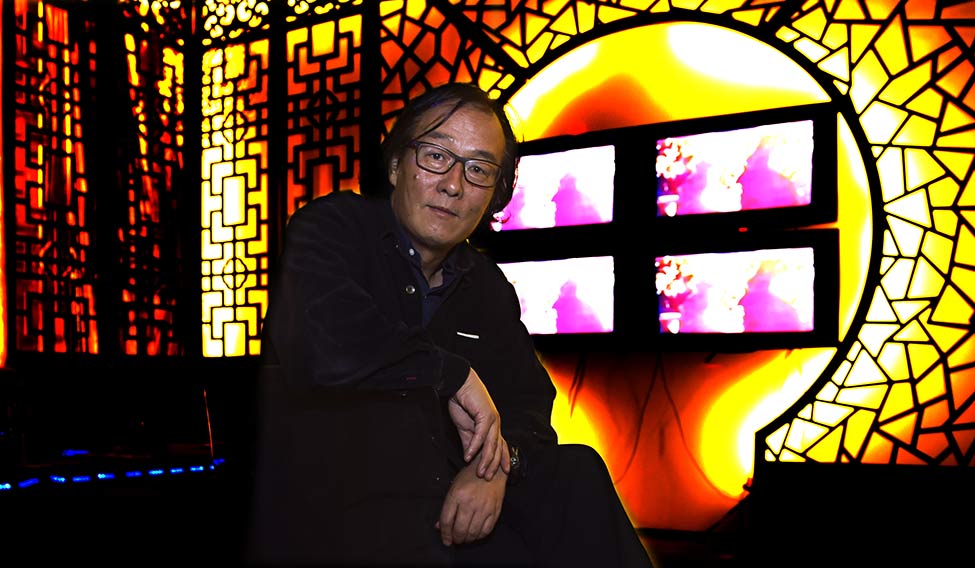 Mao Tong Qiang juxtaposed the personal with the political in his work.
Mao Tong Qiang juxtaposed the personal with the political in his work.
Komu says that Krishnamachari being invited to curate the biennale at Yinchuan might be a sign of confidence and the emergence of interest in India. The invitation coming from China is a good thing as we can make use of the better infrastructure—an activated museum space—to make the Indian experience visible in a global arena, says Komu. “Bose’s curation of the Yinchuan biennale shows that if you’re given sophisticated infrastructure, you can operate much better than western curators,” he says. Krishnamachari can easily consider the success of the biennale a personal victory. After all, as someone said, good networking and connections alone can’t ensure the success of a show. It takes honesty and integrity to do that.



